Sources
- Vértes, Edit (1990). Szibériai nyelvrokonaink hitvilága (in Hungarian). Budapest: Tankönyvkiadó. ISBN 963-18-2603-1. The title means: “Belief systems of our language relatives in Siberia”.
Among the Nenets people of Siberia, Nga was the god of death, as well as one of two demiurges, or supreme gods.
According to one story, the world threatened to collapse on itself. To try to halt this cataclysm a shaman sought the advice of the other demiurge, Num. The shaman was advised to travel below the earth, to Nga's domain and call upon him. The shaman did as told and was wed with Nga's daughter. After that point he began to support the world in his hand and became known as "The Old Man of the Earth." In another myth, Num and Nga create the world, collaborating and also competing with each other — the myth is an example of dualistic cosmology. [1]

Inuit religion is the shared spiritual beliefs and practices of the Inuit, an indigenous people from Alaska, Canada, parts of Siberia and Greenland. Their religion shares many similarities with some Alaska Native religions. Traditional Inuit religious practices include animism and shamanism, in which spiritual healers mediate with spirits. Today many Inuit follow Christianity, but traditional Inuit spirituality continues as part of a living, oral tradition and part of contemporary Inuit society. Inuit who balance indigenous and Christian theology practice religious syncretism.

Korean mythology is the group of myths told by historical and modern Koreans. There are two types: the written, literary mythology in traditional histories, mostly about the founding monarchs of various historical kingdoms, and the much larger and more diverse oral mythology, mostly narratives sung by shamans or priestesses (mansin) in rituals invoking the gods and which are still considered sacred today.
Mat Zemlya is the Earth Mother and is probably the oldest deity in Slavic mythology. She is also called Mati Syra Zemlya meaning Damp Mother Earth or Moist Mother Earth. Her identity later blended into that of Mokosh.
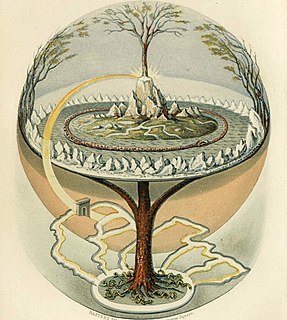
The world tree is a motif present in several religions and mythologies, particularly Indo-European religions, Siberian religions, and Native American religions. The world tree is represented as a colossal tree which supports the heavens, thereby connecting the heavens, the terrestrial world, and, through its roots, the underworld. It may also be strongly connected to the motif of the tree of life, but it is the source of wisdom of the ages.
Timaeus is one of Plato's dialogues, mostly in the form of a long monologue given by Critias, written c. 360 BC. The work puts forward speculation on the nature of the physical world and human beings and is followed by the dialogue Critias.

Kets are a tribe of Yeniseian speaking people in Siberia. During the Russian Empire, they were known as Ostyaks, without differentiating them from several other Siberian people. Later, they became known as Yenisei Ostyaks because they lived in the middle and lower basin of the Yenisei River in the Krasnoyarsk Krai district of Russia. The modern Kets lived along the eastern middle stretch of the river before being assimilated politically into Russia between the 17th and 19th centuries. According to the 2010 census, there were 1,220 Kets in Russia.

Erlik, Erlig, Erlik Khan, Erleg or Yerleg is the god of death and the underworld, sometimes referred to as Tamag (hell) in Turkic mythology. Er means Earth, in the depths of which Erlik lives in. From the underworld, Erlik brings forth death, plague and evil spirits to torment humans and take their souls into his realm. Since Tengrism is not based on a written corpus but encompasses the experienced spiritual life of Turkic people, there are no unanimous beliefs among all Turkic people. Bahaeddin Ögel argues that some ideas regarding Erlik root in Manichaeism or Persian mythology and correspond to Ahriman.

Tengrism is an ancient ethnic and state Turko-Mongolic religion originating in the Eurasian steppes, based on folk shamanism, animism and generally centered around the titular sky god Tengri.
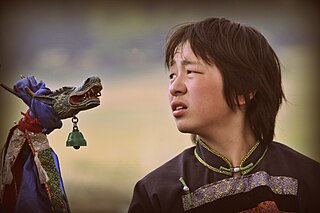
A large minority of people in North Asia, particularly in Siberia, follow the religio-cultural practices of shamanism. Some researchers regard Siberia as the heartland of shamanism.
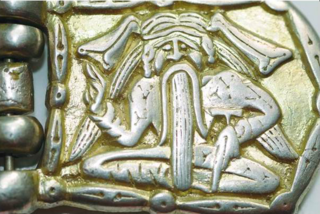
Hungarian shamanism is discovered through comparative methods in ethnology, designed to analyse and search ethnographic data of Hungarian folktales, songs, language, comparative cultures, and historical sources.
Dualism in cosmology or dualistic cosmology is the moral or spiritual belief that two fundamental concepts exist, which often oppose each other. It is an umbrella term that covers a diversity of views from various religions, including both traditional religions and scriptural religions.
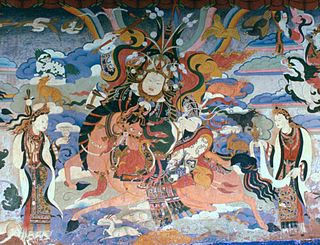
The Mongol mythology is the traditional religion of the Mongols.
Elements of a Proto-Uralic religion can be recovered from reconstructions of the Proto-Uralic language.
Buga is a creator god and omnipotent highest power in the mythology of the Tungusic peoples.
The spirit spouse is a widespread element of shamanism, distributed through all continents and at all cultural levels. Often, these spirit husbands/wives are seen as the primary helping spirits of the shaman, who assist them in their work, and help them gain power in the world of spirit. The relationships shamans have with their spirit spouses may be expressed in romantic, sexual, or purely symbolic ways, and may include gender transformation as a part of correctly pairing with their "spouse". Shamans report engaging with their spirit spouses through dreams, trance, and other ritual elements. In some cultures, gaining a spirit spouse is a necessary and expected part of initiation into becoming a shaman. Examples of spirit spouses may be seen in non-shamanic cultures as well, including dreams about Jesus Christ by nuns, who are considered to be "brides of Christ".
The Tungusic creation myths are traditional stories of the creation of the world belonging to the Tungusic peoples of Siberia.
Among the Nenets people of Siberia, the male Num was the sky god, the good creator of earth and the high god of the Nenets. Num is one of two demiurges, or supreme gods. The Nenets believed earth and all living things were created by the god Num and every heavenly sphere is ruled by one son of the Num god. Nga was his malevolent son.
The San religion is the traditional religion and mythology of the San people. It is poorly attested due to their interactions with Christianity.
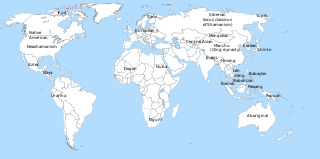
Shamanism is found in many parts of the world in many forms, each varying greatly by region.
Lower mythology is a sphere of mythological representations relating to characters who have no divine status, demons and spirits, as opposed to higher gods and the official cult. This opposition is particularly pronounced in world religions.